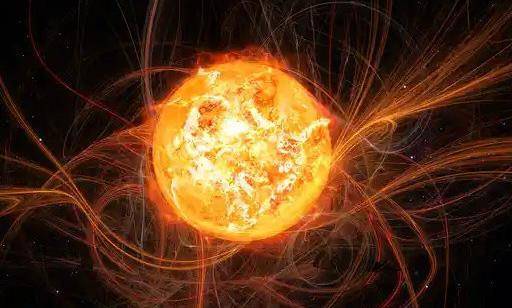The hot sun‘s surface is about 5,700 degrees Celsius, emitting bright and harsh light. When we look up close, the surface appears to be bubbling, like boiling water. Some of these bubbles are relatively dimmer, and they are slightly cooler than others, but every inch of the sun is scorching hot.
Layer by layer –
We continue our journey, passing through a giant bubble on the surface of the sun to our first stop: the troposphere.
Surrounding us is a hot fluid called plasma. As the hot air rises and the cold air sinks, the plasma is filled with bubbles. The bubbles are moving, getting bigger and smaller. Some of the bubbles may even burst as our spacecraft continues its downward flight, like a ship swaying violently in a turbulent sea.
After flying 200,000 kilometers down (equivalent to 15 times the width of the Earth), the rocking finally stopped. We reached the second stop, the radiant layer.
This part of the sun is very hot, and outside the spacecraft is 2 million degrees. Assuming we could see individual particles of light, photons, we would see them bouncing back and forth between tiny particles called atoms. Plasma is made up of these atoms.
These bouncing back and forth, left and right, form a “dance” called a “random walk.” It takes thousands of years for a photon to randomly walk out of this layer.
But our ship is going full steam ahead, so it takes far less time than photons to pass through this layer.
The weight of all the plasma above us was pushing down, making the plasma around us denser than gold and raising the surrounding temperature to 15 million degrees! We are nearing the final stop of our journey – the core of the sun.
Welcome to the nuclear department – before we get to the nuclear department, we have to shrink down to the size of the atom. Because that’s the only way we can understand what’s going on here, and it’s filled with atoms millions of times smaller than a grain of sand.
The core of the sun has an uncountable number of nuclei of hydrogen atoms, the lightest element in the universe. Extremely high pressure and heat push the atoms so close that they coalesce into a new, heavier atom.
This is nuclear fusion, and it consists of two hydrogen atoms fused together to form a completely different substance – helium.
Now that we’re in the core of the sun, what does it look like? In addition to being extremely bright, it may have a rather pink color.
We’re not entirely sure what the nucleus looks like to the human eye, but we’ve seen hydrogen plasma glow pink in our labs on Earth. So we can speculate from this that the hydrogen plasma in the core of the sun also has a similar color.
(Pictured: The hydrogen plasma glows pink in a fusion experiment at Lawrence Berkeley National Laboratory. Credit: Marilyn Chung/Lawrence Berkeley National Laboratory)
When atoms merge, they give off a lot of energy in the form of light. Light travels up through the nucleus, into the radiative layer, and bounces back and forth in it until it finally successfully enters the troposphere. The light then travels through many bubbles of plasma to the surface of the sun, from where it travels freely and uninterruptedly into space.
It’s time to leave the hottest place in the solar system and return to Earth. We traveled deep into the Sun’s interior 700,000 kilometers deep, through the bubbles of the troposphere, radiating tens of thousands of rays, and finally to the mysterious nucleus where atoms fuse.
When we return to Earth and look up at the sun in the sky, it is as if we were looking back in time. We now understand that the light we see was created thousands of years ago in the hottest places in the solar system.
Related knowledge The core of the sun is considered to be the area from the center point to 0.2 times the radius of the sun, which is the hottest place in the solar system. It has a density of up to 150,000 kg/m³ (150 times the density of water on Earth) and a temperature of 15,000,000 K (compared to the surface temperature of the sun, which is about 5600 degrees Celsius).
The sun’s energy comes primarily from nuclear fusion reactions when hydrogen is fused into helium. The core is the only place inside the sun where energy can be generated through nuclear fusion, releasing heat in the form of sunlight, and the energy transmitted from the core heats the rest of the sun. All the energy generated by nuclear fusion must travel through the various layers within the sun many times before it can escape the sun in the form of sunlight or the kinetic energy of particles.




GIPHY App Key not set. Please check settings